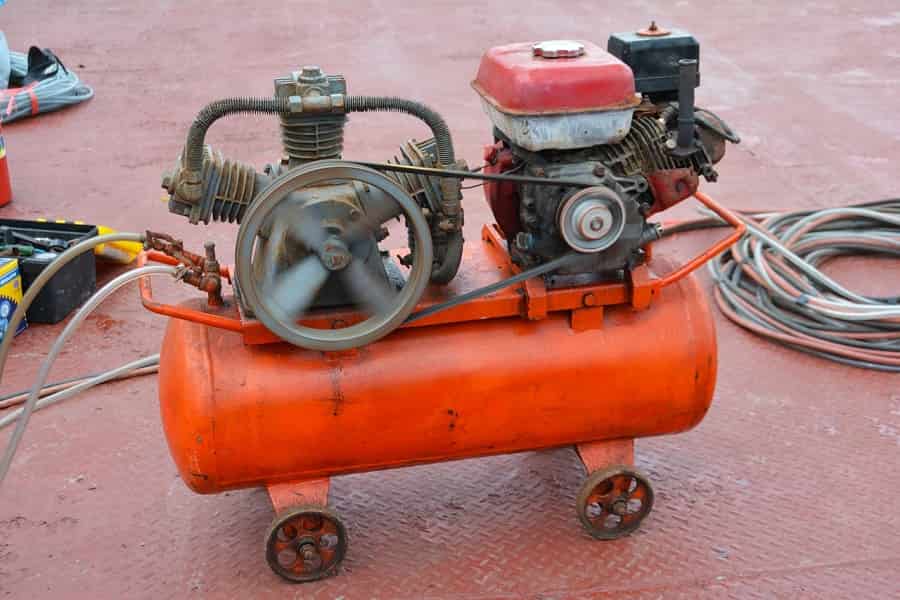Leaving any air compressor or any tank under air pressure is not good when not in use. Keep in mind that your air compressor has accessories that can break down over time, and not releasing air from your compressor will lead to all these accessories leaking and leading to some other problems that we will go through (below). Now, owning an air compressor means that you’ll frequently have to perform preventive service; always following and applying the owner’s service manual guidelines is necessary.
There are also some important questions about air compressors, such as Should you use an automatic compressor drain kit?, How often should you drain your air compressor? What happens if the air compressor is not drained? And some other important factors to consider. Before we get into these questions, it is important to note that not having a compressor in good working order can lead to some severe problems that can be preventable.
Related Air compressor made in USA
For more on air compressor made in USA read the full article.
How Air Compressors Work (Rotary and Reciprocating)
A compressor is a machine that takes mechanical input energy, usually from a motor, and converts it into fluid air energy. Air compressors with a piston as the compression element are called reciprocating compressors. Compressors can also be manufactured with veins or impellers, and these types of compressors are called rotary compressors.
Rotary Air Compressor
Rotary air compressors typically consist of a cylindrical housing with adjustable rotary vanes, an inlet, and an outlet. The vanes are on an offset driveshaft. As the shaft turns, the vanes slide in and out to keep contact with the compressor’s cylindrical wall, thus creating chambers within the cylinder of different sizes. The air enters the larger chamber; as the vanes rotate, they retract, causing the chamber to become smaller and compress the air, and then the air exits into the smaller chamber. Rotary compressors are usually free of the vibrations and pulsations that occur in reciprocating compressors.
Reciprocating Air Compressor
An average reciprocating compressor consists of a housing with an internal piston connected to a crankshaft. There are two valves in the cylinder head: an inlet and an outlet valve. The inlet, sometimes called the suction valve, lets atmospheric air enter the cylinder. The outlet sometimes called the dump valve, expels freshly compressed air from the cylinder as the crankshaft rotates the piston down and up, changing the volume available inside the cylinder. The piston’s downward stroke is called the suction stroke, and the upward stroke is called the compression stroke.
Suction Stroke of Reciprocating Air Compressor
As the piston moves down its sectional stroke, the volume increases inside the cylinder. As the volume increases, the pressure inside the cylinder is less than the inlet air pressure; this lets the higher pressure outside air push open the inlet valve letting more air enter the cylinder.
Compression Stroke of Reciprocating Air Compressor
When the cylinder begins its upward compression stroke, the volume inside the cylinder decreases. The decrease in volume causes the pressure inside the cylinder to increase. The increased pressure opens the outlet valve, and the compressed air exits the cylinder.
Single Stage Air Compressor
Single-stage air compressors have only one piston and one cylinder and compress air in a single stage. A single-stage compressor typically has a compression ratio of 5 to 1 with an output pressure between 50 and 75 PSI. By compressing the air, it gets hotter and hotter. If the air gets too hot, not only is the compression cycle is less efficient, but it can also lead to an explosion if any hydrocarbon material, such as oil or lubricant, comes in contact with the superheated air.
Two Stage Air Compressor
To avoid the danger of overheating with the one-stage compressor mentioned above and still generate higher pressures, manufacturers make compressors with several stages.
Stage One Cycle
In the first stage, the air gets compressed, which is usually the largest. It is then cooled and compressed in the second stage, i.e., the second piston. The hot compressed air from the first stage is directed to the second stage through a thin tube exposed to air from a flywheel fan. After the air cools inside the tube, the compressed air enters the second stage to compress further.
Stage Two Cycle
The compressed air going to the second stage is sometimes referred to as supercharged air. Two-stage compressors have a compression ratio of 3 to 1 or even less per stage but can run up to 175 PSI. They can also push more air at a higher pressure than single-stage compressors of the same horsepower. If pressures above 175 PSI are needed, multi-stage compressors should be used.
In larger compressors, cooling can be accomplished by circulating water instead of air. Up to six or seven stages with cooling in between may be required to achieve a pressure of 2500 PSI. Their versatility makes compressors one of the main components in air production.
Related Are air tools power tools?
For more on air tools read the full article.
How to Use an Air Compressor (7 easy steps)
Whether you use your compressor to spray paint or inflate a tire, don’t just plug it in. Follow these essential steps for safety and to keep your garage tools running for years to come. Here’s what you’ll need: safety goggles, an air compressor instruction manual, Oil, power tools, and power supply.
1. Mount the Air Compressor
Mount the air compressor according to the manufacturer’s installation instructions. Connect the hose to the regulating valve.
2. Check Oil level
Inspect the oil level and add oil if needed.
3. Check Electrical Outlet and Relief Valve
Plug the compressor into a grounded three-prong outlet. Check that the system relief valve is set correctly. The system relief valve is a safety device that will open if the pressure rises beyond what the compressor can handle, thus preventing system failure.
4. Turn-On the Air Compressor
Turn on the compressor to pump the tank and then close the tank drain valve.
5. Connect the Air Power Tool
Connect a power air tool to the hose. Adjust the compressor to the specifications of the tool and the project you are working on. Never exceed the power tool manufacturer’s recommended pressure.
6. Turn-Off Air Compressor
Turn off and disconnect your air compressor. Remove the tool and then the hose when you are done.
7. Drain and Store Air Compressor
And the final step you should always do is to drain your air compressor. Store your compressor away from the elements to be in perfect working order the next time you need it.
Draining an Air Compressor Alternative
After doing some analysis, I came across this interesting video that provides a good alternative for reducing some of the tank’s moisture by using an auxiliary tank.
I hope this video gives you some useful input on keeping your air compressor and air tools in good working condition away from moisture. Keeping our air compressors from getting moisture is like going against gravity; no matter what you do to your air compressor, it will always pick up water. But one thing we can do is redirect some of that moisture somewhere else, away from the air compressor tank.
Should You Use an Automatic Compressor Drain Kit?
I highly recommend installing one of these automatic compressor kits, and here’s why. Most air compressor manufacturers put the valve at the bottom of the compressor, and the problem is that no one goes down there, and no one empties that, at least not as often as they should. So what happens is that each time your air compressor is running and cycling, it’s pulling a lot of air; with that air comes a lot of moisture. Remember that ambient humidity can change drastically depending on where you live, which affects your power tools.
However, regardless of your location, installing one of these compressor drain kits is a necessity. Therefore, having an automatic drain is a great convenience because you don’t have to fiddle with getting down on your knees and trying to turn the valve, and then getting a bunch of gunk on your face. There are many automatic drain kits for air compressors; make sure it matches the same capacity 110v or 240v, which means if your compressor runs on 110v, you will need a 110v automatic drain kit.
This is optional but if you purchase one of these air compressor drain kits, be sure to power it from the compressor and not from the wall outlet. This way, you will eliminate two electrical sources to run your compressor, and always follow the installation guidelines.
How Often Should You Drain Your Air Compressor?
Draining the water from your air compressor should be done daily. As the hot air reaches the tank, it cools and then basically acts almost like a natural dryer, so the moisture will automatically drop out and sit in the tank. If you don’t remember or don’t remember to do it daily, it will continue to build up. Therefore, it is best when purchasing your compressor, to get the self-drain kit mentioned above, or you can also get a timer drain. The timer drain runs every so often and opens automatically to drain any moisture in the tank.
What Happens if The Air Compressor is Not Drained?
When the air compressor is not drained daily, the water settles in the tank, and then the tank will rust from the inside out. So you won’t get the tank’s longevity, and then the other bad part is that the water has to go somewhere. And what ends up happening, whether you have a dryer or not, is that water will go right into your airlines, and then you’ll start having water discharged through your tools. Not only will it destroy your air compressor over time, but it will also ruin your tools because of the water running through it.
Should You Leave Air Compressor Drain Open?
Some owners’ manuals recommend keeping the air compressor drain open during storage; however, this could lead to debris and insects entering the air compressor system. In this case, we can apply logic, i.e., if you have drained your air compressor properly, I see no need to leave the drain valve open. If you think you want to leave this valve open, I suggest you turn it a quarter turn to prevent debris and insects from entering the tank.
Related
- Also, you can learn more about the ideal air compressor size and air tools.
- Need an Impact Wrench? Here’s what to consider.

